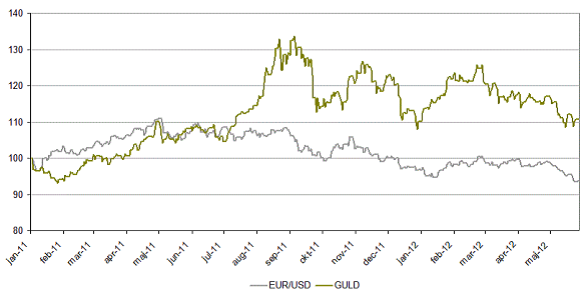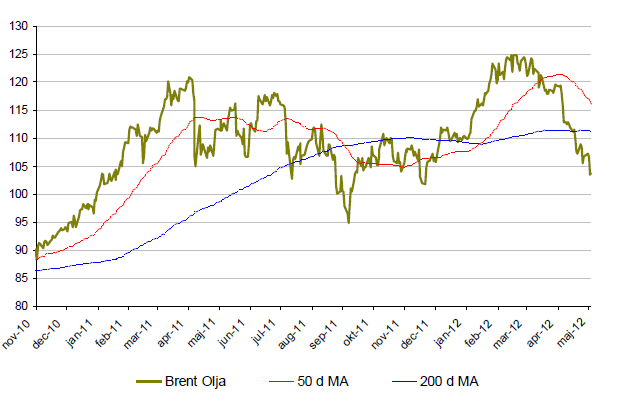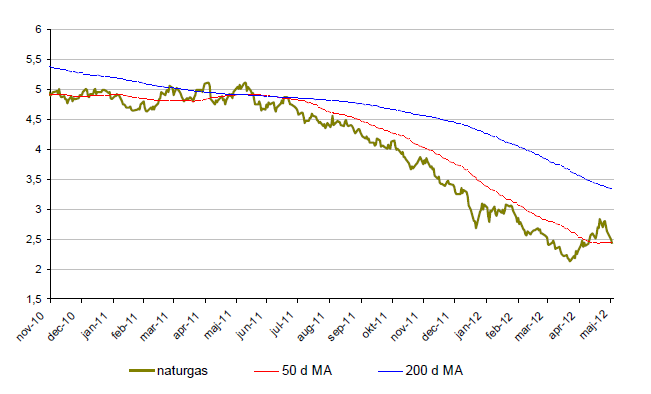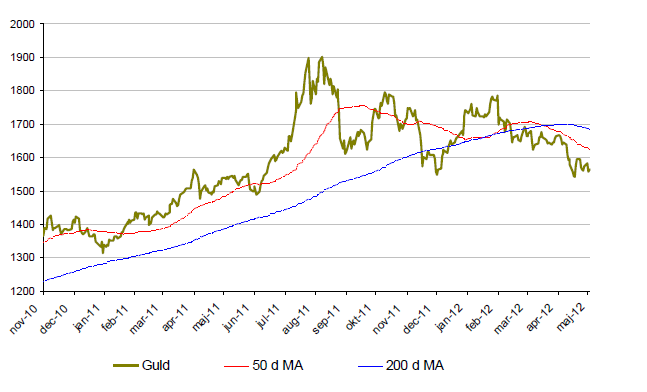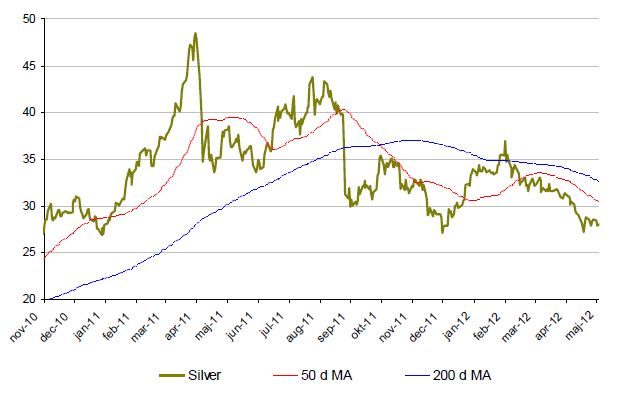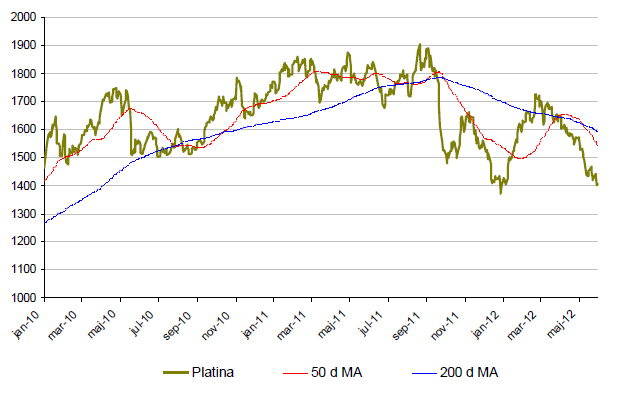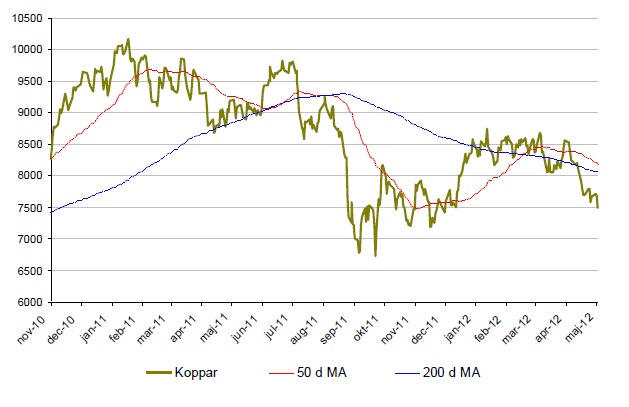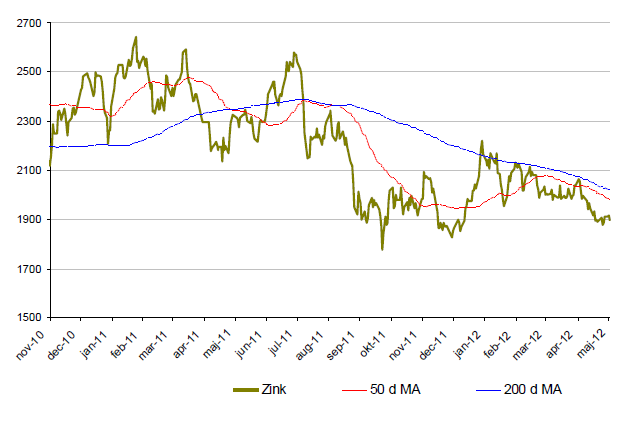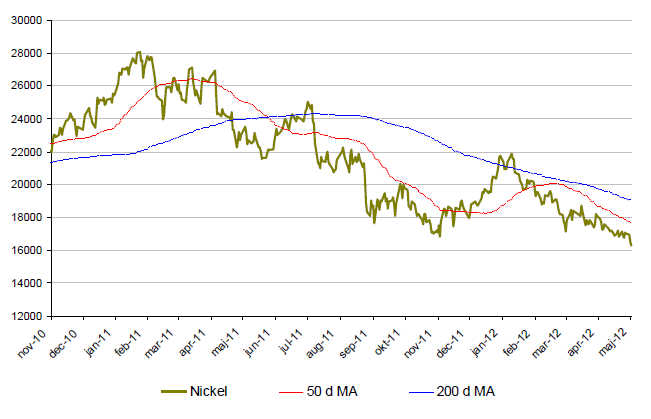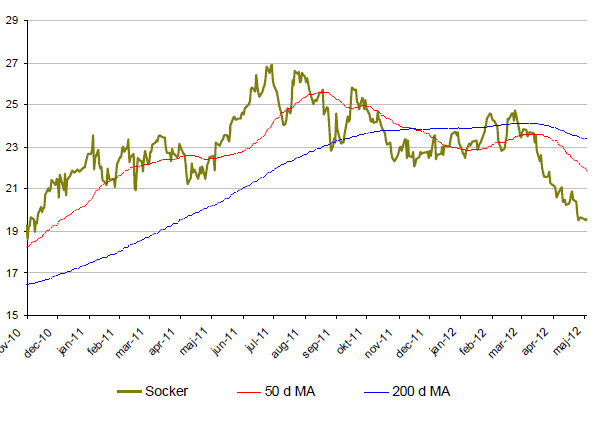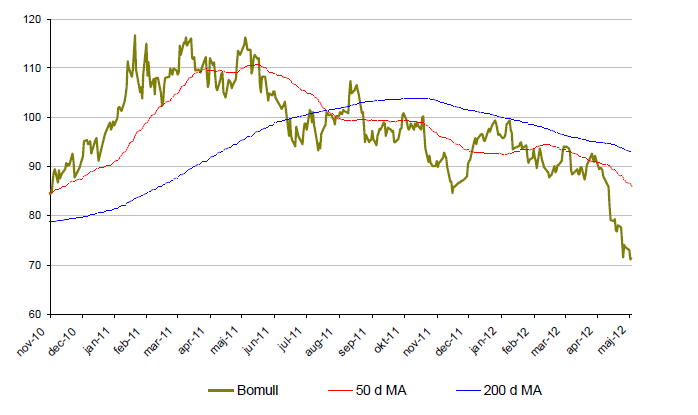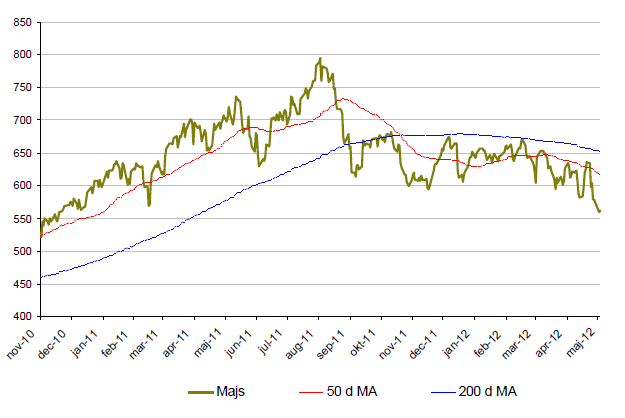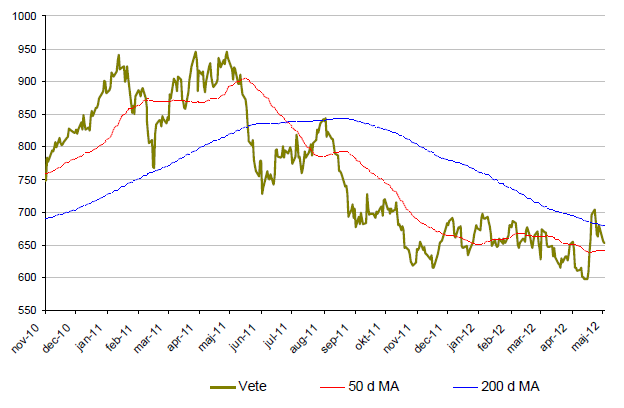Analys
SIP Nordic – Råvaruguiden – juni 2012
 Råvaror och Grexit
Råvaror och Grexit
Det spekuleras vilt i medierna om ett potentiellt Grekiskt utträde ur EU, även kallat Grexit. Det debatteras fram och tillbaka om hur troligt detta scenario är. Frågan jag ställer mig är hur detta kommer påverka råvaror och i synnerhet ädelmetallen guld.
De senaste veckorna har debatten kring den grekiska krisen eskalerat igen. Valet för några veckor sedan, där politikerna misslyckades att sätta ihop en regering, ökade oroligheten för att Grekland inte kommer att kunna fullfölja de budgetåtaganden som den förra regeringen klubbat igenom. Nyvalet i mitten av juni kommer att vara mycket viktigt, inte enbart för den europeiska ekonomin utan också för den framtida utvecklingen för råvaror.
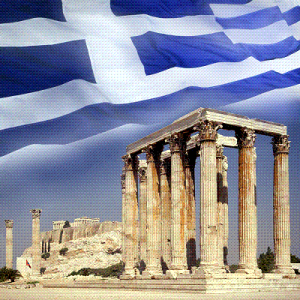 Man kan lugnt säga att ECB har en tuff sommar framför sig med en potentiell Grexit men också sämre utsikter för bland annat Spanien och Italien.
Man kan lugnt säga att ECB har en tuff sommar framför sig med en potentiell Grexit men också sämre utsikter för bland annat Spanien och Italien.
‘Att ECB måste trycka nya pengar är nog inte en dålig gissning, något som kommer att kunna straffa euron och som i sin tur kommer att påverka råvarorna.
En svagare euro kontra dollarna har historiskt sett en negativ påverkan på bland annat ädelmetallerna guld och silver. Många kommer säkert ihåg förra årets skriverier om USAs dåliga ekonomi som fick dollarna att falla och guldet att klättra upp till nivåer kring 1900$/oz. Nu ser vi det omvända.
Den europeiska krisen har till och med fått de allra mest pessimistiska att tro på en EUR/USD kurs kring 1.00 (nu kring 1.25). Det är alltså ingen dålig gissning att guld kan falla om EUR/USD också faller. Som bilden nedan visar har Guld haft en stark koppling till EUR/USD den senaste tiden.
Detta grundar sig i att om dollarn blir starkare jämfört med andra valutor blir guld dyrt att investera i för utländska investerare. Självklart är det så att är många fler faktorer än dollarkursen som styr guldpriset men jag kommer i alla fall hålla koll på kursen den närmaste tiden.
Råvaror – Energi
Brent olja
- Brentoljan är nu för första gången i år nere på negativa siffror. Drygt 3% ned för året.
- Under maj månad har Brent-oljan tappat nästan 13%.
- En viktig faktor är den stärkta dollarn kontra andra valutor vilket pressar priset på oljan.
- Rekordhöga lagernivåer driver ned priset. Oroligheterna i mellanöstern som drev upp oljepriset i början av året verkar nu vara utraderade.
- Säljare av olja blir fler och fler vilket i kombination av en stärkt dollar och höga lagernivåer kan tala för ett fortsatt fall i oljepriset. $100 är en viktig nivå.
Naturgas
- Naturgas fortsätter att stiga. Under maj månad har naturgas stigit ytterligare 5%.
- Under april-maj har priset på naturgas ökat med nästan 14%.
- För året är dock naturgas ned drygt 20%.
- Lagren av naturgas väntas öka under 2012 med 26 %.
- Trots stora naturgaslager ökar priset på naturgas vilket dels kan förklaras av att temperaturen i USA spås ligga under det normala i juni och juli.
Råvaror – Metaller
Guld
- Guld fortsätter att tappa under maj. Under maj månad är guld ned ca. 6%.
- Sedan i slutet av februari har guld tappat drygt 12% och ligger nu +-0 för året.
- Reuters publicerade i april sin guldundersökning. Där förutspås en guldkurs som fluktuerar i ett stort spann men som ligger något över dagens nivåer vid årets slut.
- En starkare dollar kontra andra valutor, med euron i spetsen, bidrar till kräftgången i guldpriset.
- Olika centralbanker med Mexiko, Ryssland och Sydkorea i spetsen köpte under 2011/2012 455 ton guld. Det största inköpet sedan 1964.
Silver
- Silvers kraftiga uppgång under jan-feb raderades under maj månad.
- Efter en nedgång på över 10% i maj är nu silver +-0 för året.
- Silverproduktionen väntas öka 4% under 2012.
- Överskottet av silver väntas i slutet av 2012 bli smått otroliga 5060 ton.
- Den europiska kreditkrisen i kombination med rädsla för minskad kinesisk tillväxt bidrar till de negativa sentimenten i silver.
- Att dollarn stärkts mot euron bidrar även till den fallande trenden.
Platina
- Likt de andra ädelmetallerna är platina ned under maj månad. Nedgången stannade vid knappa 11%.
- För året är platina upp knappa 2%.
- Platina fortsätter at handlas till en billigare kurs än guld. Analytikerna spår dock att platina kommer vara den dyrare av de två vid slutet av året.
- Den starka dollarn sätter även här käpparna i hjulet på platinapriset.
- Efter strejken vid Rustenburggruvan i Sydafrika ökar nu lagren av platina samtidigt som efterfrågan minskar.
Koppar
- Kan tyckas tjatigt men även koppar tappade under maj månad. Nedgången med nästan 14% raderar ut hela årets uppgång.
- Kopparinventarierna ligger på låga nivåer och lagren av koppar räcker endast i tre veckor.
- Samma siffra väntas sjunka till 2.8 under 2013 vilket kan trycka upp kopparpriset ytterligare.
- Den största risken ligger i att Kina, med 40% av världskonsumtionen, står inför en minskande tillväxt.
Zink
- Den tunga månaden för metaller gäller även för zink. Zink är under maj månad ned ca. 8%. För året är zink upp drygt 3,5%.
- Zinklagrena är mer än fulla vilket kan komma att pressa priset ytterligare.
- Kina är återigen en viktig bricka i spelet. En minskad tillväxt i Kina kommer troligtvis ha en betydande effekt på zinkpriset. Kina står för 43% av världens konsumtion.
- Det uppskattas att nuvarande zinktillgång skulle räcka 9,1 veckor, 2,6 veckor längre än 2011.
Nickel
- Nickel presterade sämst av alla basmetaller under 2011.
- Nickel fortsätter sin kräftgång under 2012. I maj backade nickel över 8% och är för året ned nästan 9%.
- Nickelmarknaden är mättad med ökande lager.
- Produktionen väntas överstiga konsumtionen under 2012. Mängden tillgänglig nickel väntas dock minska under 2013 och i kombination med ett bättre marknadsläge spår analytikerna ett högre nickelpris under 2013.
- Nuvarande nickelnivåer räcker för 9,1 veckors konsumtion. Ca en vecka högre än 2011.
Råvaror – Jordbruk
Socker
- Socker startade året starkt, till följd av dåliga och torra väderförhållandena i världens största sockerproducerande land, Brasilien.
- Sedan mars faller dock socker kraftigt. Indien producerar och exporterar socker i hög fart vilket resulterat i att socker under mars-maj tappat nästan 24%.
- I Indien, som öppnat för obegränsad export, spås rekordskördar.
- Genomsnittspositionen är fortsatt lång men säljarna börjar nu bli fler och fler.
Bomull
- Bomull är för året ned ca 26% där merparten av nedgången kom i maj. I maj föll bomullspriset med närmare 20%.
- Rekordexport av bomull från Indien pressar priset.
- Trots att bomullspriset fallit kraftigt under 2012 är det fortfarande nästan dubbelt så högt som priset för några år sedan. Fallhöjden är således stor.
Majs
- Majspriset är under maj månad ned över 14% vilket också motsvarar årsnedgpngen i majs.
- Den kommande skörden vänats vara av mycket god kvalitet.
- För att den negativa trenden i majs ska brytas krävs fortsatt torka i USA. Regnväder är dock att vänta under sommamånaderna.
- Statistik som visar USA-exporten av majs ökar kraftigt. Kina importerar nu rekordstora mängder majs.
Vete
- Vetepriset är under maj månad upp nästan 7% till följd av torra väderförhållanden i USA, Kina och Europa.
- För året är dock vete ned dryga 1%.
- Spekulanterna har under maj månad skiftat tro. Antalet korta positioner har minskat kraftigt.
Apelsinjuice
- Priset på apelsinjuice fortsätter att falla som en sten. Under maj månad är priset apelsinjuice ned 26%.
- Det finns fortfarande fallhöjd i kursen då apelsinjuice har stigit med nästan 70 % sedan 2009.
- Skörden I Florida är mycket god till följd av frostfria väderförhållanden. Samtidigt visar rapporter att efterfrågan på apelsinjuice minskar vilken kyler av priset.
[box]Denna uppdatering är producerat av SIP Nordic och publiceras i samarbete och med tillstånd på Råvarumarknaden.se[/box]
Ansvarsbegränsning
Detta produktblad utgör endast marknadsföring och har sammanställts av SIP Nordic Fondkommission AB.
Innehållet ger inte fullständig information avseende det finansiella instrumentet. Investerare uppmanas att del av prospekt och slutliga villkor, vilka finns tillgängliga på: www.rbsbank.se/markets, innan ett investeringsbeslut tas.
Förekommande exempel är simulerade och baseras på SIP Nordics egna beräkningar och antaganden, en person som använder andra data eller antaganden kan nå andra resultat. Administrativa avgifter och transaktionsavgifter påverkar den faktiska avkastningen.
Analys
Tightening fundamentals – bullish inventories from DOE

The latest weekly report from the US DOE showed a substantial drawdown across key petroleum categories, adding more upside potential to the fundamental picture.

Commercial crude inventories (excl. SPR) fell by 5.8 million barrels, bringing total inventories down to 415.1 million barrels. Now sitting 11% below the five-year seasonal norm and placed in the lowest 2015-2022 range (see picture below).
Product inventories also tightened further last week. Gasoline inventories declined by 2.1 million barrels, with reductions seen in both finished gasoline and blending components. Current gasoline levels are about 3% below the five-year average for this time of year.
Among products, the most notable move came in diesel, where inventories dropped by almost 4.1 million barrels, deepening the deficit to around 20% below seasonal norms – continuing to underscore the persistent supply tightness in diesel markets.
The only area of inventory growth was in propane/propylene, which posted a significant 5.1-million-barrel build and now stands 9% above the five-year average.
Total commercial petroleum inventories (crude plus refined products) declined by 4.2 million barrels on the week, reinforcing the overall tightening of US crude and products.


Analys
Bombs to ”ceasefire” in hours – Brent below $70

A classic case of “buy the rumor, sell the news” played out in oil markets, as Brent crude has dropped sharply – down nearly USD 10 per barrel since yesterday evening – following Iran’s retaliatory strike on a U.S. air base in Qatar. The immediate reaction was: “That was it?” The strike followed a carefully calibrated, non-escalatory playbook, avoiding direct threats to energy infrastructure or disruption of shipping through the Strait of Hormuz – thus calming worst-case fears.

After Monday morning’s sharp spike to USD 81.4 per barrel, triggered by the U.S. bombing of Iranian nuclear facilities, oil prices drifted sideways in anticipation of a potential Iranian response. That response came with advance warning and caused limited physical damage. Early this morning, both the U.S. President and Iranian state media announced a ceasefire, effectively placing a lid on the immediate conflict risk – at least for now.
As a result, Brent crude has now fallen by a total of USD 12 from Monday’s peak, currently trading around USD 69 per barrel.
Looking beyond geopolitics, the market will now shift its focus to the upcoming OPEC+ meeting in early July. Saudi Arabia’s decision to increase output earlier this year – despite falling prices – has drawn renewed attention considering recent developments. Some suggest this was a response to U.S. pressure to offset potential Iranian supply losses.
However, consensus is that the move was driven more by internal OPEC+ dynamics. After years of curbing production to support prices, Riyadh had grown frustrated with quota-busting by several members (notably Kazakhstan). With Saudi Arabia cutting up to 2 million barrels per day – roughly 2% of global supply – returns were diminishing, and the risk of losing market share was rising. The production increase is widely seen as an effort to reassert leadership and restore discipline within the group.
That said, the FT recently stated that, the Saudis remain wary of past missteps. In 2018, Riyadh ramped up output at Trump’s request ahead of Iran sanctions, only to see prices collapse when the U.S. granted broad waivers – triggering oversupply. Officials have reportedly made it clear they don’t intend to repeat that mistake.
The recent visit by President Trump to Saudi Arabia, which included agreements on AI, defense, and nuclear cooperation, suggests a broader strategic alignment. This has fueled speculation about a quiet “pump-for-politics” deal behind recent production moves.
Looking ahead, oil prices have now retraced the entire rally sparked by the June 13 Israel–Iran escalation. This retreat provides more political and policy space for both the U.S. and Saudi Arabia. Specifically, it makes it easier for Riyadh to scale back its three recent production hikes of 411,000 barrels each, potentially returning to more moderate increases of 137,000 barrels for August and September.
In short: with no major loss of Iranian supply to the market, OPEC+ – led by Saudi Arabia – no longer needs to compensate for a disruption that hasn’t materialized, especially not to please the U.S. at the cost of its own market strategy. As the Saudis themselves have signaled, they are unlikely to repeat previous mistakes.
Conclusion: With Brent now in the high USD 60s, buying oil looks fundamentally justified. The geopolitical premium has deflated, but tensions between Israel and Iran remain unresolved – and the risk of missteps and renewed escalation still lingers. In fact, even this morning, reports have emerged of renewed missile fire despite the declared “truce.” The path forward may be calmer – but it is far from stable.
Analys
A muted price reaction. Market looks relaxed, but it is still on edge waiting for what Iran will do

Brent crossed the 80-line this morning but quickly fell back assigning limited probability for Iran choosing to close the Strait of Hormuz. Brent traded in a range of USD 70.56 – 79.04/b last week as the market fluctuated between ”Iran wants a deal” and ”US is about to attack Iran”. At the end of the week though, Donald Trump managed to convince markets (and probably also Iran) that he would make a decision within two weeks. I.e. no imminent attack. Previously when when he has talked about ”making a decision within two weeks” he has often ended up doing nothing in the end. The oil market relaxed as a result and the week ended at USD 77.01/b which is just USD 6/b above the year to date average of USD 71/b.

Brent jumped to USD 81.4/b this morning, the highest since mid-January, but then quickly fell back to a current price of USD 78.2/b which is only up 1.5% versus the close on Friday. As such the market is pricing a fairly low probability that Iran will actually close the Strait of Hormuz. Probably because it will hurt Iranian oil exports as well as the global oil market.
It was however all smoke and mirrors. Deception. The US attacked Iran on Saturday. The attack involved 125 warplanes, submarines and surface warships and 14 bunker buster bombs were dropped on Iranian nuclear sites including Fordow, Natanz and Isfahan. In response the Iranian Parliament voted in support of closing the Strait of Hormuz where some 17 mb of crude and products is transported to the global market every day plus significant volumes of LNG. This is however merely an advise to the Supreme leader Ayatollah Ali Khamenei and the Supreme National Security Council which sits with the final and actual decision.
No supply of oil is lost yet. It is about the risk of Iran closing the Strait of Hormuz or not. So far not a single drop of oil supply has been lost to the global market. The price at the moment is all about the assessed risk of loss of supply. Will Iran choose to choke of the Strait of Hormuz or not? That is the big question. It would be painful for US consumers, for Donald Trump’s voter base, for the global economy but also for Iran and its population which relies on oil exports and income from selling oil out of that Strait as well. As such it is not a no-brainer choice for Iran to close the Strait for oil exports. And looking at the il price this morning it is clear that the oil market doesn’t assign a very high probability of it happening. It is however probably well within the capability of Iran to close the Strait off with rockets, mines, air-drones and possibly sea-drones. Just look at how Ukraine has been able to control and damage the Russian Black Sea fleet.
What to do about the highly enriched uranium which has gone missing? While the US and Israel can celebrate their destruction of Iranian nuclear facilities they are also scratching their heads over what to do with the lost Iranian nuclear material. Iran had 408 kg of highly enriched uranium (IAEA). Almost weapons grade. Enough for some 10 nuclear warheads. It seems to have been transported out of Fordow before the attack this weekend.
The market is still on edge. USD 80-something/b seems sensible while we wait. The oil market reaction to this weekend’s events is very muted so far. The market is still on edge awaiting what Iran will do. Because Iran will do something. But what and when? An oil price of 80-something seems like a sensible level until something do happen.
-

 Nyheter3 veckor sedan
Nyheter3 veckor sedanMahvie Minerals växlar spår – satsar fullt ut på guld
-

 Nyheter4 veckor sedan
Nyheter4 veckor sedanUppgången i oljepriset planade ut under helgen
-

 Nyheter4 veckor sedan
Nyheter4 veckor sedanLåga elpriser i sommar – men mellersta Sverige får en ökning
-

 Nyheter3 veckor sedan
Nyheter3 veckor sedanOljan, guldet och marknadens oroande tystnad
-

 Analys3 veckor sedan
Analys3 veckor sedanA muted price reaction. Market looks relaxed, but it is still on edge waiting for what Iran will do
-

 Nyheter3 veckor sedan
Nyheter3 veckor sedanJonas Lindvall är tillbaka med ett nytt oljebolag, Perthro, som ska börsnoteras
-

 Analys4 veckor sedan
Analys4 veckor sedanVery relaxed at USD 75/b. Risk barometer will likely fluctuate to higher levels with Brent into the 80ies or higher coming 2-3 weeks
-

 Nyheter3 veckor sedan
Nyheter3 veckor sedanDomstolen ger klartecken till Lappland Guldprospektering


